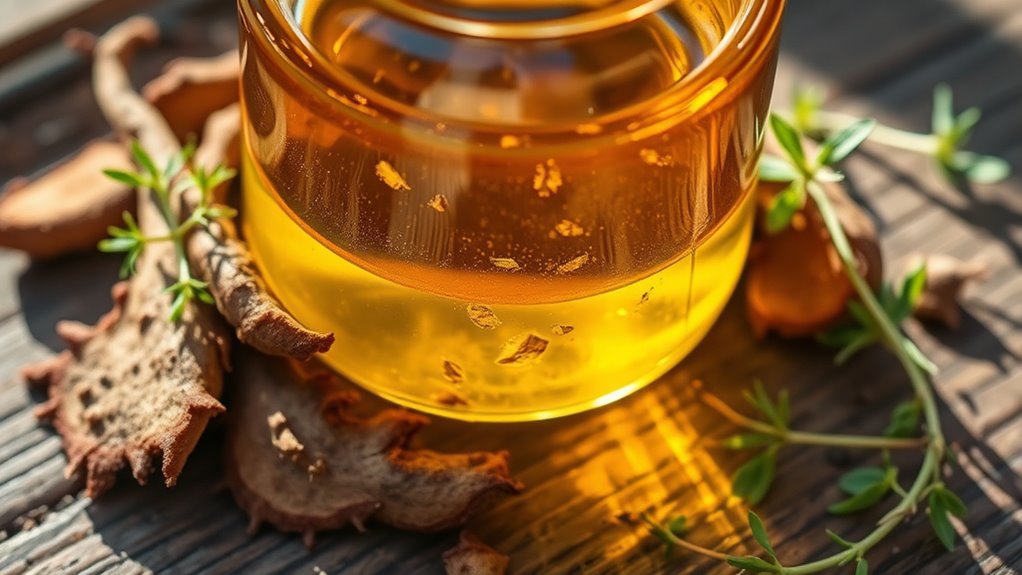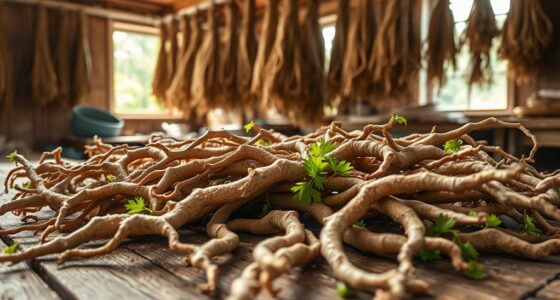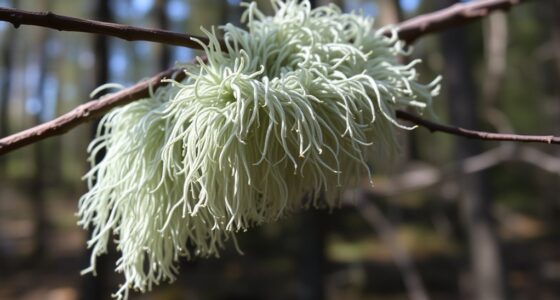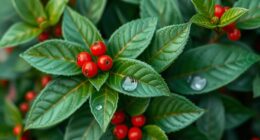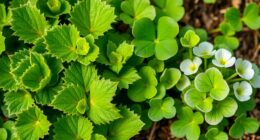To make digestive bitters with dandelion root, start by harvesting fresh or dried roots, ensuring they’re healthy and properly identified. Wash and dry the roots, then chop them into small pieces. Fill a jar with the roots and cover them with high-proof alcohol like vodka, sealing tightly. Store in a dark place for 4-6 weeks, shaking occasionally. Once steeped, strain the mixture and transfer it into dark bottles. Keep your tincture in a cool, dark spot—learn more about perfecting your blend and usage tips ahead.
Key Takeaways
- Tincture dandelion root by steeping chopped roots in high-proof alcohol for 4–6 weeks to create digestive bitters.
- Use fresh or dried roots, ensuring they are clean and properly prepared before tincturing.
- Label the tincture clearly with name, date, and alcohol content; store in a cool, dark place for potency.
- Take 1-2 droppers of the tincture before or after meals to stimulate digestion and bile production.
- Combine dandelion root tincture with other herbs like ginger or peppermint for enhanced digestive benefits.
Understanding the Benefits of Dandelion Root for Digestion

Dandelion root has long been valued for its ability to support healthy digestion. As an herbal remedy, it promotes digestive health by stimulating bile production, which aids in breaking down fats and improving overall gut function. When you incorporate dandelion root into your routine, you may notice relief from indigestion, bloating, and sluggish digestion. Its natural compounds help detoxify the liver and kidneys, further supporting your digestive system. Many traditional herbal remedies include dandelion root for its gentle yet effective properties. By using it as a tincture, you harness its benefits conveniently, making it easier to integrate into daily wellness practices. Additionally, sustainable harvesting of dandelion root ensures that harvesting methods are environmentally friendly, aligning with principles of sustainable living. Overall, dandelion root stands out as a powerful botanical ally for maintaining a healthy, balanced digestive system.
Gathering Supplies and Ingredients for Your Tincture
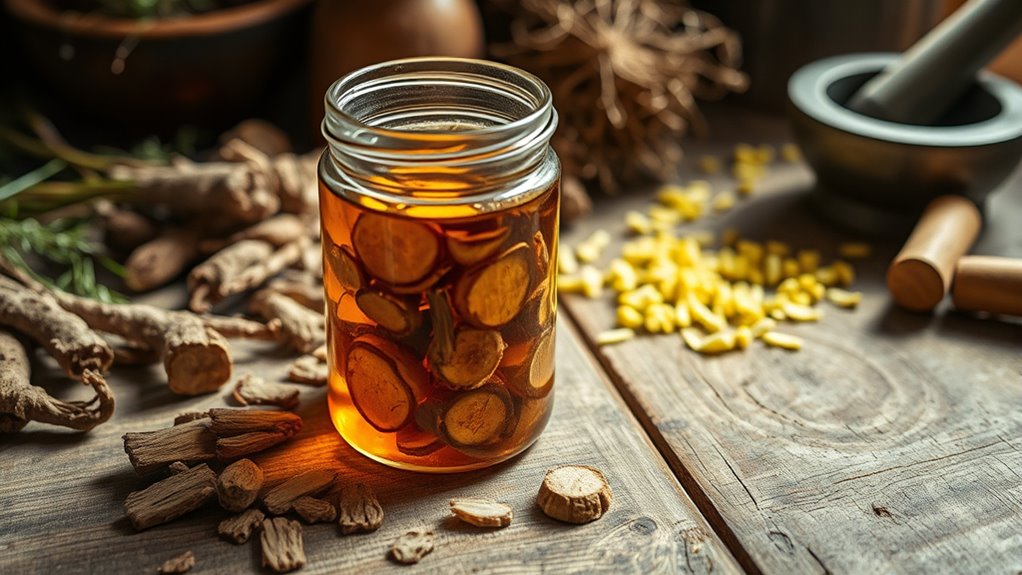
To create an effective tincture, start by gathering quality ingredients and supplies. Use fresh or dried dandelion roots to maximize herbal synergy, enhancing the tincture’s effectiveness. Confirm your jars, filters, and alcohol are food-grade to support proper tincture extraction. A high-proof alcohol like vodka works best for extracting active compounds from the roots. You may also want a mortar and pestle to crush the roots, increasing surface area for extraction. Label your jars clearly and keep them in a cool, dark place to preserve potency. Gathering the right supplies ensures your tincture captures the full spectrum of beneficial constituents. Paying attention to ingredient quality and proper tools guarantees a potent, effective digestive bitters tincture. Additionally, choosing floating on water containers can help prevent contamination during storage and infusion.
Selecting the Best Dandelion Roots for Tincturing
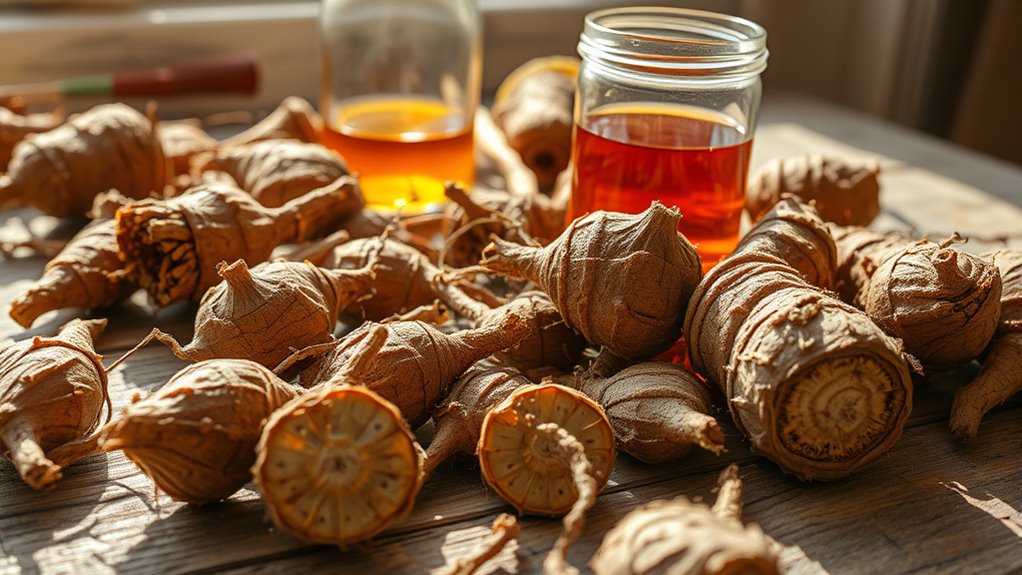
When choosing dandelion roots for tincturing, look for fresh, firm roots without signs of mold or shriveling. The best time to harvest is when the plant is actively growing, usually in early spring or fall, for maximum potency. Paying attention to these indicators guarantees you select high-quality roots for your digestive bitters. Additionally, selecting roots with high-quality paint extraction ensures a more effective tincture.
Root Freshness Indicators
How can you tell if dandelion roots are fresh enough for tincturing? Look for clear root freshness indicators that signal ideal harvesting timing. Fresh roots are firm, plump, and have a smooth surface without wrinkles or shriveling. They should feel heavy for their size, indicating moisture content. The color should be a vibrant, healthy hue—typically a light tan or cream. To guarantee quality, avoid roots that are dry, brittle,, or discolored, which suggest age or improper storage. Additionally, proper harvesting techniques are essential to ensure you select the best roots for tincturing.
Optimal Harvesting Time
Timing your harvest is essential for obtaining the most potent dandelion roots for tincturing. The best time to harvest depends on the harvesting moon, ideally during a new or full moon, when the plant’s energies are most concentrated. Roots are at their peak maturity when they’re thick, firm, and have developed a deep color, usually in late fall after the plant has gone to seed. Avoid harvesting too early, as immature roots lack potency, or too late, when roots may become woody and less effective. Pay attention to the plant’s growth cycle; mature roots contain higher concentrations of beneficial compounds. Additionally, understanding the plant’s growth cycle can help optimize potency and ensure a successful tincture. By aligning your harvest with the moon cycle and root maturity, you ensure a potent, effective tincture.
Preparing Dandelion Roots Before Tincturing
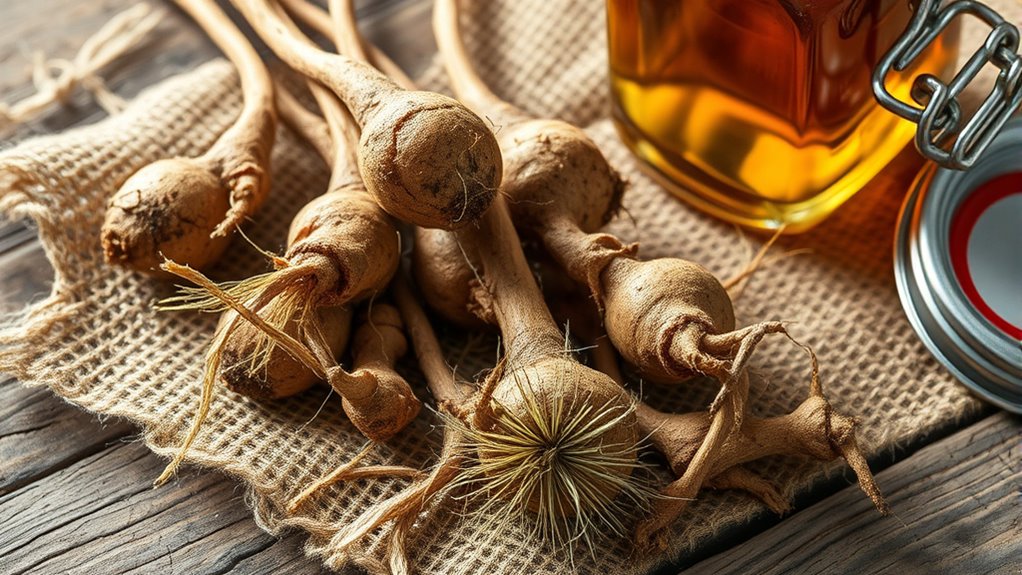
Before tincturing, you need to harvest your dandelion roots at the right time, typically in the fall. Afterward, clean them thoroughly and dry them properly to preserve their medicinal qualities. Finally, store the roots in a cool, dark place until you’re ready to make your tincture. Incorporating data privacy concerns into your preparation can help ensure your process remains secure and compliant with regulations.
Harvesting Dandelion Roots
To prepare dandelion roots for tincturing, start by carefully digging around the plant’s base to avoid damaging the roots. Proper root harvesting begins with accurate plant identification—ensure you’re harvesting true dandelions (Taraxacum officinale). Once identified, loosen the soil gently to prevent breaking the roots.
Here are three key steps:
- Use a garden fork or trowel to carefully lift the plant, keeping roots intact.
- Select healthy, thick roots free of rot or disease.
- Gently wash off excess soil, being cautious not to damage the root structure.
Cleaning and Drying Methods
After harvesting, it’s essential to clean the dandelion roots thoroughly to remove dirt and debris that could affect the tincturing process. Use water and a brush to gently scrub away soil. For better purification, consider soaking the roots briefly in water, then rinsing again. Once clean, drying methods become vital to prevent mold and preserve potency. Air drying in a well-ventilated, shaded area is a simple and effective technique. Alternatively, you can use a dehydrator set to a low temperature or an oven at the lowest setting, ensuring the roots dry evenly without cooking. Proper drying not only halts microbial activity but also concentrates the active compounds, making your tincture more effective. Using an appropriate drying method helps maintain the roots’ medicinal qualities. Choose the method that best suits your space and timeline for ideal results.
Proper Root Storage
Proper root storage is essential to maintaining the quality and potency of your dandelion roots before tincturing. Correct root storage ensures ideal dandelion preservation, preventing mold, rot, or loss of active compounds. To achieve this, you should: 1. Store roots in a cool, dark, and dry place to slow down degradation. 2. Use breathable containers like paper bags or mesh baskets to prevent moisture buildup. 3. Keep roots away from direct sunlight and humidity, which can compromise their potency. Additionally, choosing appropriate self watering plant pots can help maintain optimal moisture levels for stored roots if needed.
Step-by-Step Guide to Making Your Dandelion Root Tincture
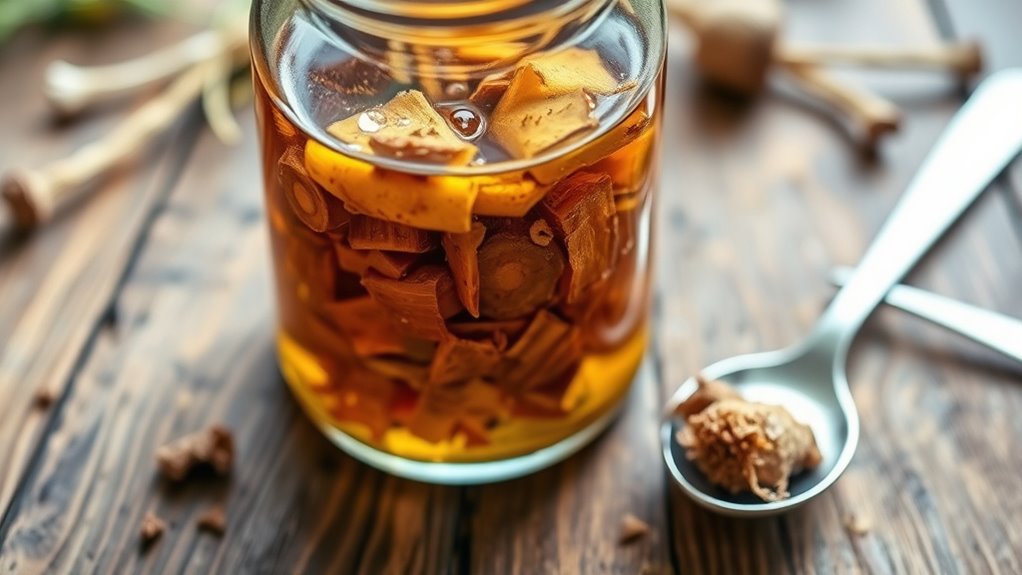
Making a dandelion root tincture is a straightforward process that allows you to harness the plant’s detoxifying properties. Start by cleaning and chopping fresh or dried roots into small pieces. Place the roots in a clean glass jar, filling it about halfway. Cover them with high-proof alcohol, like vodka, ensuring the roots are fully submerged. Seal the jar tightly. Store it in a cool, dark place for 4 to 6 weeks, shaking it gently every few days to extract the active compounds. Remember, herbal safety is essential—use quality ingredients and proper alcohol levels. After the steeping period, strain out the roots and transfer the tincture into dark glass bottles for storage. Proper tincture storage preserves potency and prevents degradation, ensuring your herbal remedy remains effective. Herbal preparation techniques are vital to maximize the benefits of your tincture and ensure safety.
Properly Labeling and Storing Your Herbal Tincture
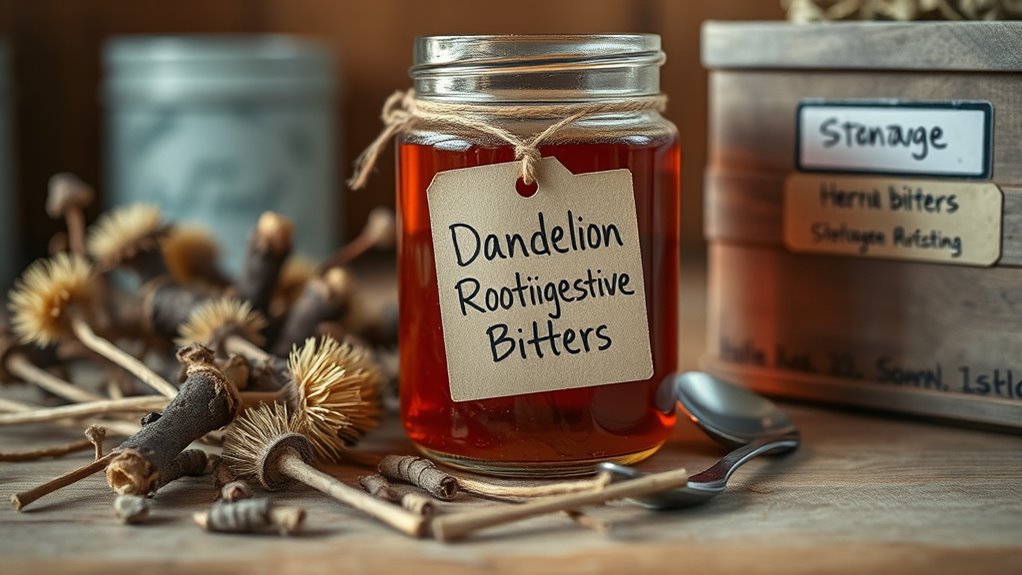
Labeling and storing your herbal tincture correctly guarantees its potency and safety over time. To assure this, follow labeling best practices, such as including the tincture’s name, date of preparation, and alcohol content. Use clear, water-resistant labels to prevent smudging or fading. When it comes to storage container options, opt for dark glass bottles like amber or cobalt to protect the tincture from light degradation. Keep containers tightly sealed to prevent evaporation and contamination. Store your tincture in a cool, dark place away from direct sunlight and temperature fluctuations. Proper labeling and thoughtful storage not only preserve the tincture’s efficacy but also make it easier to identify and use when needed.
How to Use Dandelion Root Tincture for Digestive Support

Dandelion root tincture is a versatile herbal remedy that can effectively support your digestive health. To maximize its benefits, take a small dose (about 1-2 droppers) before or after meals. This allows the dandelion’s nutrient profile, rich in dandelion nutrition, to stimulate digestion and promote liver function. Incorporating herbs known for their digestive support can further enhance its effects. Consistent use helps improve bile flow and reduce bloating. Remember that herbal synergy plays a key role; combining dandelion with herbs like ginger or peppermint can enhance its effects. You can also add the tincture to water or tea for easier consumption. Monitor how your body responds and adjust the dosage accordingly. Incorporating dandelion root tincture into your routine offers a natural, targeted way to support your digestive system daily.
Safety Tips and Precautions When Using Digestive Bitters
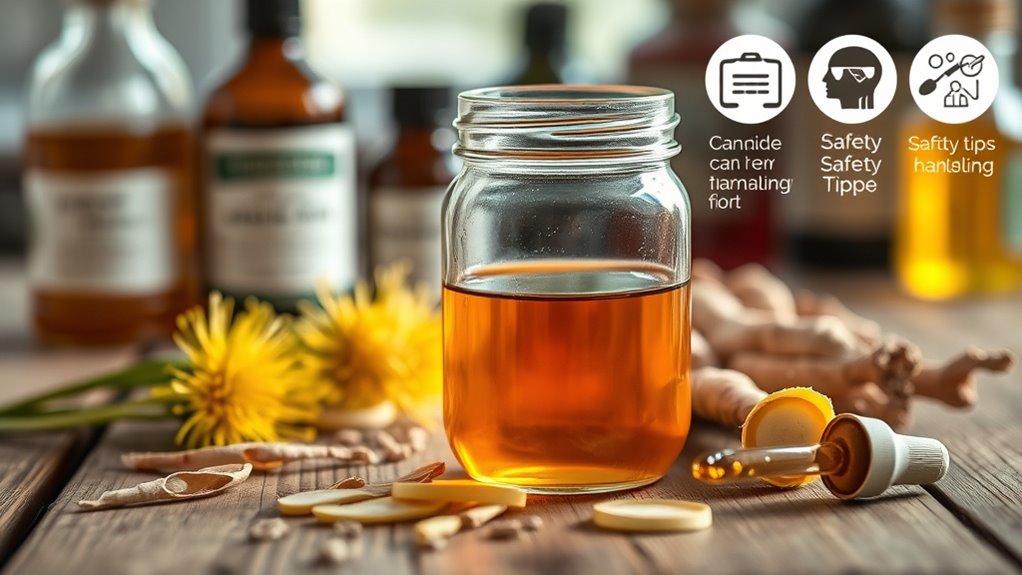
While digestive bitters can offer many health benefits, it’s important to use them safely and responsibly. Always start with a small dose to gauge your body’s response. Be aware of possible interactions with medications, especially blood thinners or diabetic drugs, as bitters may alter their effects. Take allergy precautions by checking ingredient labels for potential allergens like herbs or botanicals you’re sensitive to. Consult your healthcare provider if you’re pregnant, nursing, or have existing health conditions.
- Monitor for possible interactions with medications or supplements.
- Conduct a patch test to check for allergy reactions before regular use.
- Use caution if you have liver or kidney issues, and seek medical advice.
Adjusting Dosage and Incorporating Tinctures Into Your Routine

To effectively incorporate digestive bitters tinctures into your routine, it’s important to start with a low dose and gradually increase as needed. Dosing adjustments help prevent discomfort and ensure you find the right amount for your body. Begin with a few drops or a small teaspoon before meals, then observe how you feel. If necessary, slowly increase the dose over several days. Routine integration involves consistent use at the same times each day, which helps your body adapt and maximizes benefits. Keep track of your responses and modify accordingly. Remember, patience is key—too much too soon can be overwhelming. By fine-tuning your dosage and establishing a routine, you ensure the tincture supports your digestive health effectively and safely.
Additional Herbs to Combine With Dandelion for Enhanced Benefits

Combining dandelion with other herbs can amplify its detoxifying and digestive benefits. By selecting herbal synergists, you can create tinctures that support liver function and stimulate digestion more effectively. Additionally, these combinations can lead to flavor enhancements, making your herbal remedies more palatable. Consider these herbs:
- Ginger – boosts digestion, reduces inflammation, and adds a spicy warmth.
- Milk Thistle – supports liver detoxification and enhances overall cleansing.
- Peppermint – eases bloating, calms stomach discomfort, and offers a revitalizing note.
These herbs not only complement dandelion’s benefits but also improve the tincture’s taste and potency. Experimenting with these herbal synergists allows you to tailor your bitters for maximum digestive support and flavor balance.
Frequently Asked Questions
Can I Make Dandelion Root Tincture With Dried Roots Only?
Yes, you can make a dandelion root tincture with dried roots only. For tincture preparation, use dried roots by chopping them into small pieces to increase surface area. Fill a jar with the chopped dried roots, then cover them with alcohol, like vodka. Let it steep for 4-6 weeks, shaking occasionally. This method guarantees you extract the beneficial compounds effectively from the dried roots.
How Long Does Homemade Dandelion Root Tincture Last?
Think of your homemade dandelion root tincture as a fine wine—it can last years if stored properly. Typically, with good storage conditions—dark, cool, and in a sealed glass jar—it stays potent for 2 to 5 years. Over time, its shelf life diminishes, but proper storage maintains its benefits. Keep it away from sunlight and heat to ensure it remains effective and safe to use.
Are There Any Contraindications for Using Dandelion Root Tincture?
You should be aware of potential contraindications when using dandelion root tincture. Some people might experience allergic reactions, especially if they’re sensitive to plants in the Asteraceae family. It can also interact with medications like diuretics or blood thinners, so check with your healthcare provider before use. If you notice any adverse effects, discontinue use and seek medical advice promptly.
What Is the Best Alcohol Percentage for Tincturing Dandelion Root?
You should aim for an alcohol strength of around 45-60% for tincturing dandelion root, as this range balances alcohol strength and tincture efficacy. This concentration effectively extracts beneficial compounds without over-solubilizing undesirable ones. Using alcohol within this percentage guarantees your tincture preserves potency and stability, making it easier to store and use. Adjusting the alcohol strength slightly within this range can optimize the extraction based on your preferences.
Can Dandelion Root Tincture Be Used for Other Health Issues Besides Digestion?
Imagine your dandelion root tincture as a versatile key opening multiple health doors. Besides aiding digestion, you can explore its potential as an herbal interaction booster for liver support, detoxification, and skin health. Its gentle, herbal symphony may help with inflammation or fluid retention. Always remember to consult a healthcare professional, as the tincture’s broad spectrum might influence other remedies or conditions, making it a powerful, yet cautious, herbal ally.
Conclusion
With your tincture ready, imagine a warm cup of herbal goodness gently easing your digestion, like a calming breeze through a sunlit meadow. Each drop of dandelion bitters can become a trusted companion, guiding your gut back to harmony. As you incorporate this herbal treasure into your routine, picture your digestive system flowing effortlessly, vibrant and balanced—nature’s gentle touch helping you feel grounded, renewed, and ready to embrace each day with energy.

